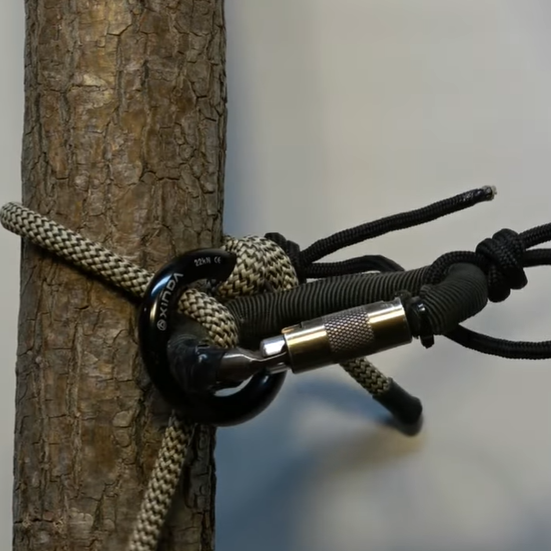
Page Contents:
Description
The JRB Cinch is an advanceable and retrievable anchor, suitable for use on a trunk given that it cinches in place. It is constructed with a rappel ring and carabiner. Note that although a JRB Cinch could be constructed with steel components, steel and aluminum components should not be mixed. Usages:
- A JRB Cinch on the end of the rope can be used as a Lifeline/ or Tether.
- One JRB Cinch on each end of the rope can be used to create a climbing system.
See related pages:
Features
- Easy to set, unset and advance
- Can be advanced with one hand
- Can be advanced with the use of the Maverick pole
- Remotely Retrievable (requires effort)
- Can be used in SRT, Stick Climbing & JRB Hitch Climbing
- Can be reconstructed quickly (new w/2024 version)
Maverick Pole
The Maverick Pole is recommended for use with the JRB Cinch. It can be purchased at Ape Canyon Outfitters. See dedicated page:
Securing the Ring
The JRB Cinch requires securing a Rappel Ring to the end of the rope.
The original (2022) design for the Cinch used a Buffalo Hitch (link at bottom of page). The JRB Cinch was redesigned 2024, using a Moose Hitch. Both behave the same way, but the 2024 version is much easier to build, remove and re-build, which is necessary in trees which do not allow the cinch to pass through a crotch during retrieval.
A common question is if a Scaffold Knot or Poacher’s Knot can be used instead. The problem with those knots is that they are extremely difficult to remove after loading, and might need to be cut off.
Supporting Videos
This video preceded the one above, showing the construction of the JRB Cinch, but in the woods, thus the production quality was not as good, here for reference, if needed.
How to tie the Moose hitch:
Items required
As outlined in the JRB Cinch 2024 video above, besides your rope, there are 3 items needed to build the JRB Cinch:
Item 1: Ring: On 8mm ropes, a small or a large aluminum Rappel Ring works. On 9 mm and larger ropes, use a Large Rappel Ring. Ape Canyon’s product link is below; see Shopping List page if out of stock, or for other options.
Item 2: Carabiner. JRB prefers a D-style or pear shaped aluminum carabiner for the JRB Cinch so that it stays in place in the ring. This is the preferred carabiner.
For other choices, see the separate page for Carabiners.
Item 3: Cord. A 36″ length of utility cord (4 or 5mm is great), is used to create a tether which connects the carabiner to the rope. The finished tether should be about 15-16″ long.
Optional: JRB’s recommended method to minimize clinking sound when operating the JRB Cinch is to cut about 4″ of tubular webbing and slide it over the carabiner and secure it with tape. See the Shopping List page for product links.
History
For historical reference, this is the introductory video from 2022: